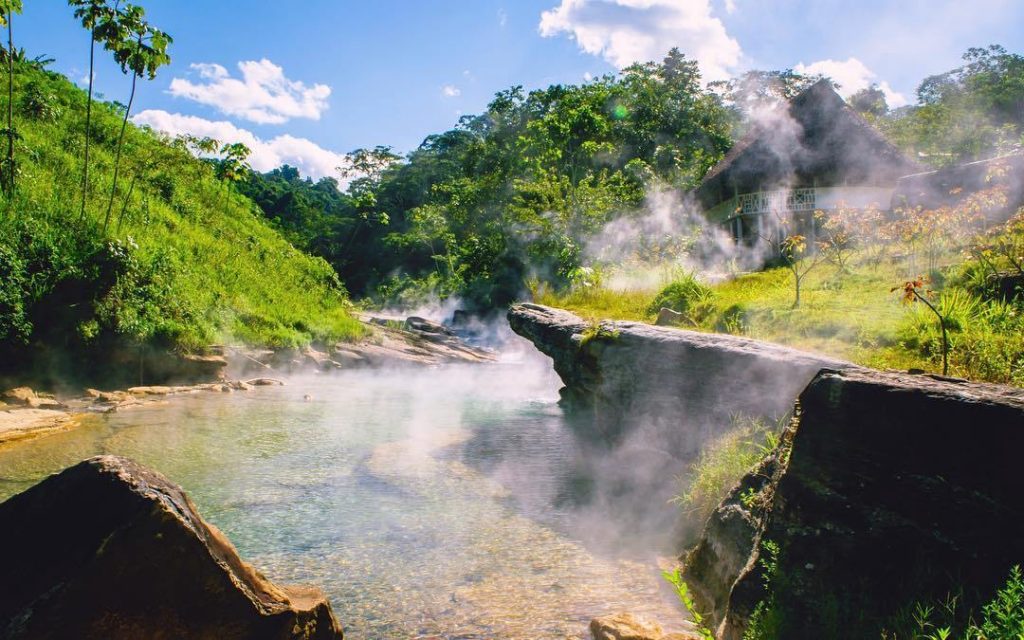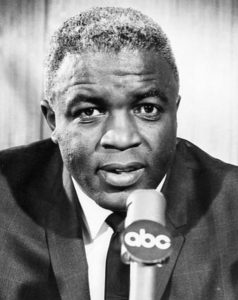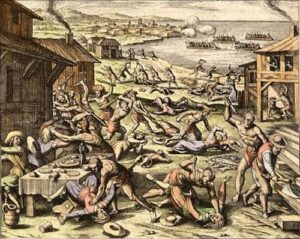Winner of the Fall 2018 StMU History Media Award for
Best Article in the Category of “Latin American History”
In the city of Lima, it is traditional for grandparents to tell stories to their grandsons at family dinner gatherings. One grandson, who heard a story handed down through many generations, is named Andrés Ruzo. When he was little, his grandparents told him stories about the Spanish and their conquest of Peru. One of those stories told that after the Incas had been conquered by the Spanish, the conquerors had grown rich and powerful, because of the huge amounts of gold they had taken from the Incas. But some of those men just wanted more, so they went into towns asking the Incas, “Where can we get more gold?” With their land usurped and their people slaughtered, the Inca wanted vengeance. They told the greedy conquistadors to go to the Amazon and search for a city made out of gold that they called Paititi (“El Dorado” in Spanish and “The Golden One” in English).1 The Amazon, the largest tropical forest in the world, has an area of seven million square kilometers and goes through five Latin-American countries, but mostly through Brazil and Peru.2

The likelihood of someone having built a city of gold in this treacherous area was slim, but the avarice of the Spaniards was too great. The few men that ultimately returned from the Amazon told stories of shamans, warriors that used arrows, man-eating beasts, and the most scientifically curious aspect of this story: a river that boiled and emitted gusts of vapor.3
Twelve years later, Andrés Ruzo had become a geoscientist at the Southern Methodist University, in Dallas, Texas. While he was working on his Ph.D. at SMU, and trying to understand Peru’s geothermal energy potential–the thermal energy stored in the earth–he remembered the stories his grandfather had told him. He thought about them many times, but the best science of the time suggested that the existence of a boiling river in the largest tropical forest in the world, which was also far from a powerful heat source, was inconceivable. He wanted to confirm his suspicions for himself, so he asked professors, students, oil, gas, and mining companies about it, but they all seemed to agree that the existence of a boiling river in a zone where there are no volcanoes is impossible.4
Ruzo returned to Peru in 2011 to see his family. At a family dinner, his aunt told him that the river was real and that she had swam there. While arguing with his aunt about it, his uncle got into the conversation, agreed with her, and added that there was a shaman protecting the river. Motivated by the curiosity, Ruzo made a choice. He decided to go into the vast region of the Amazon and see for himself whether that part of the story was true or not. Because if it was true, it could become a discovery of the highest order.5
Finally, after more than two hours and forty-five minutes of travel, he was in the Amazon. Almost seven hundred kilometers away from the nearest volcanic center, he started hiking, and as he went deeper into the region, he started noticing some vapor coming from some of the trees. He went deeper until he stopped, stunned by what was in front of him; he ran into what seemed to be a shaman almost fully surrounded by vapor. He took his thermometer and the average temperature of the river was 86 degrees Celsius. After talking with this man for a while, he discovers that the man was the shaman’s apprentice. He was told that the shaman was in charge of protecting the river and that the place where he was standing was the land of the “Yacumama,” a giant snake spirit that was the mother of waters. It was a snake who creates hot and cold streams. Surprisingly, the point where the hot and cold streams mix is underneath one big rock formation that has the shape of a snake’s head, covered with moss and surrounded by vegetation.6

In describing the fulfilling experience of discovering the boiling river, Ruzo states: “This is becoming one of the greatest adventures of my life. This will be the story I tell my children and grandchildren—and every action I make at this moment adds a new piece of the story. Every passing second now seems to hold a greater significance. Burning-hot water splashes on my right arm. I sit up, pulling my arm to my chest, no longer lost in thought. I recall my professor’s words from volcanology field school: ‘the people who die on volcanoes are the inexperienced who are also ignorant of the dangers and the experts who have forgotten they are dangerous.’ I stand, make sure I have a firm footing and jump back onto the nearest shore. As I look back at the boiling river I can’t suppress an excited whisper: this place exists. This place actually exists. I remember the shaman saying the river has called me here for a purpose, and I can feel a greater mission about to take place.”7
The river started as a cold stream and continued hotter underneath the Yacumama. So the legend was pretty accurate. The data showed that the river was independent of any volcanic source. Ruzo asked how that could be possible? He asked many geothermal experts and volcanologists for years, but he still hasn’t been able to explain the reason for the temperatures, nor find another phenomenon like this. Shanay-Timpishka flows hot for 6.24 kilometers, it gets up to 25 meters wide and its temperature ranges from 25 to more than 90 degrees Celsius depending on what part of the river you are measuring. The river’s hottest temperature is almost twice as hot as a hot cup of coffee. The boiling river is an amazing and unique phenomenon, but it is also very dangerous. At 47 degrees Celsius, any creature that dares to get inside the water meets his last moments. Ruzo explained that he saw a toad fall into the waters and his body started cooking. Every minute inside that it spent struggling to get out, it got more tired until water entered his mouth and started cooking the toad from the inside. At the hottest section of the river, small animals are cooked in a matter of seconds.8

The boiling river is a beautiful and dangerous site, and it is a mystery for geoscientists to explain. We are still waiting for it to be solved. It is the largest boiling river in existence that we know of, but for the surrounding community, it is a natural resource. People cook and drink from the river; its water is clean and somewhat tasty. The river is considered so precious that Ruzo needed to talk to the shaman and receive his approval to study the river, with the condition of returning the water. The river is located in an exploitable jungle, and there are no specific laws that protect it. After the shaman said he saw no evil intentions within the young scientist, Ruzo was ready for some information gathering. He first needed to get a full image of the river, so he contacted Google Earth to get one by satellite. He later found its name: Shanay-Timpishka, which means “Boiled with the Heat of the Sun.” He was aided by National Geographic grants and started his own geophysical and geothermal studies on the river in 2011.9
After discovering one of the largest thermal rivers in the world, Ruzo published his findings, and he is now credited for making more widely known the existence of this phenomenon. With the help from his colleagues from National Geographic, Dr. Spencer Wells, and from UC Davis, Dr. Jon Eisen, he discovered new lifeforms, new species living inside the river. Apart from that, he also gathered some data indicating the presence of a large hydrothermal system (the deeper into the earth, the hotter), but he still needs more research in order to discover the exact reason for its temperatures. Since the discovery is recent, there’s not much information about the new species.10

Ruzo now understands that the shaman and the people living there kept the river a secret because it is just another piece of unprotected land waiting to be exploited by the illegal loggers and the government. Additionally, one of Ruzo’s main points for the protection of the river is its “significance,” which can be summarized in two aspects. The first is its cultural significance. It is part of Peru’s natural history and according to the shaman, it is a center of shamanic learning and a source of knowledge. The second is its geological significance. The river is huge and it is different from any other boiling river. Depending on the results, this could become a great contribution to geoscience.11
After five years of research, Ruzo has set the goal of ensuring that whoever controls the river is going to respect it and understand its “importance and uniqueness.” He is now spreading the message of “significance” in his book The Boiling River: Adventure and Discovery in the Amazon, and in boilingriver.org, which is a nonprofit organization created in 2016 that seeks to protect the river, spread the message of its significance, and provide information gathered by his research. Andrés Ruzo is an example of how useful it is to remember the stories of one’s heritage; these tales may not be concrete knowledge or facts, but they can certainly lead to amazing discoveries that may not have been found any other way.12
- Andres Ruzo, “How I Found a Mythical Boiling River in the Amazon” (New York: Simon and Schuster, 2016), 6-12. ↵
- The New Encyclopaedia Britannica, 15th ed., s.v. “Amazon River”. ↵
- Andres Ruzo, “The Boiling River: Adventure and Discovery in The Amazon,” YouTube video, 15:49, posted by TED, February 23, 2016, https://www.youtube.com/watch?v=k4N2SxUZwiU&t=604s. ↵
- Andres Ruzo, How I Found a Mythical Boiling River in the Amazon (New York: Simon and Schuster, 2016), 13-17. ↵
- Andres Ruzo, “The Boiling River: Adventure and Discovery in The Amazon”, YouTube video, 15:49, posted by TED, February 23, 2016, https://www.youtube.com/watch?v=k4N2SxUZwiU&t=604s. ↵
- Andres Ruzo, How I Found a Mythical Boiling River in the Amazon (New York: Simon and Schuster, 2016), 76-86. ↵
- Andrés Ruzo, How I Found a Mythical Boiling River in the Amazon (New York: Simon and Schuster, 2016), 1-2. ↵
- Andres Ruzo, “The Boiling River: Adventure and Discovery in The Amazon”, YouTube video, 15:49, posted by TED, February 23, 2016, https://www.youtube.com/watch?v=k4N2SxUZwiU&t=604s. ↵
- Simon Worrall, “This River Kills Everything that Falls into it. Legend or fact? A young explorer that traveled deep into a remote jungle to find out,” National Geographic, March 13, 2016. Accessed September 9, 2018, https://news.nationalgeographic.com/2016/03/160313-boiling-river-amazon-geothermal-science-conservation-ngbooktalk. ↵
- Andrés Ruzo, “The Boiling River Project,” Lumen Foundation, 2016, Accessed September 9, 2018, http://www.boilingriver.org. ↵
- Kelley McMillan, “A Boiling River Flows Through the Amazon. Can it be Saved?”, National Geographic, February 18, 2016. Accessed September 8, 2018, https://www.nationalgeographic.com/adventure/adventure-blog/2016/02/18/this-mythical-river-in-peru-is-boiling-and-one-young-scientist-is-on-a-quest-to-protect-it/. ↵
- Andres Ruzo. “The Boiling River: Adventure and Discovery in The Amazon,” YouTube video, 15:49, posted by TED, February 23, 2016, https://www.youtube.com/watch?v=k4N2SxUZwiU&t=604s. ↵



121 comments
Cassandra Sanchez
This whole story is truly fascinating, and I never knew there was a boiling river anywhere out in the world. I really love that Ruzo is trying to protect it and the cultural significance behind it. I understand the fear that it would be exploited and used wrongly, and appreciate all the efforts made to prevent that from happening. This river holds so much value for everyone who knows about it and this is something that should be preserved as much as possible.
Kenneth Gilley
I found this article very interesting because I had not heard of the boiling river until now. It is neat that what started as a family story became such a great discovery. I like how this article contained a mix of information about the river itself and how it might have formed and the cultural and historical significance of it, also. It will be interesting to see if anyone ever discovers the real reason why the boiling river is there.
Cristianna Tovar
Prior to reading this article, I had never heard of the boiling river. I must say, this topic is so fascinating, especially since not even geothermal experts can explain why the water gets so hot in some regions. The images of the river are beautiful and allow readers to appreciate and develop a deeper understanding of the river. I thought it was so interesting that such a big discovery stemmed from storytelling. This article highlights the importance of heritage and history.
Jose Maria Llano Aranalde
This is the first time that I have heard of the boiling river. The article gave a lot of information over the river as well as historical background information. It was really interesting to read. Especially because the author didn’t make it too scientific. The pictures that the author added really help the reader see how beautiful the river is.
Hector Membreno
This story is cool because it started as a family story that could have been a complete lie. But Ruzzo decided he would take his scientific studies and go out on a limb and look for it. Not only did he find it but he conducted research there and blew the minds of other scientist that said it could never so because Shanay-Timpishka was not linked to any volcanic systems.
Olivia Tijerina
I value the work done in the article of “The River that Can Cook Creatures Alive: Peru’s Mysterious Boiling River” because it talks of the importance of understanding one’s cultural heritage in such an admirable way. I enjoyed how the characters were involved throughout the story and how amazing the details were. It is quite an amazing peice/ adventure told; I can’t stress it enough what a wonderful message it had left.
Fazle
Doesn’t the Yacumma snake live at the boiling river? I think it uses it to get so massive.
Maria Garcia
This article was interesting to me because I had never heard of the boiling river until today. I absolutely loved the photographs used for the article because they show the beauty behind it all, and I just enjoy seeing nature. I can’t believe that there’s so much about not only this river, but other bodies of water that scientist have yet to discover fully about. I loved the information given! I hope Ruzo can and will continue to protect the river.
Cameron Lopez
I like the fact that Ruzo is trying to protect the river, Peruvians found the river which I’m happy about because most others might of made wrong decisions with it but instead they preserved it and protect it. Throughout the article I was trying to picture the science behind the boiling river and then I saw the picture and it made everything come together.
Matthew Swaykus
This story is absolutely fascinating. The protagonist found an extraordinary anomaly that has significant cultural and historical appeal for the people of Peru. The author also put forth the message of protecting this creation of nature by pointing to how significant to society the river is as well as the danger it faces form increased exploitation of our tropical forests.